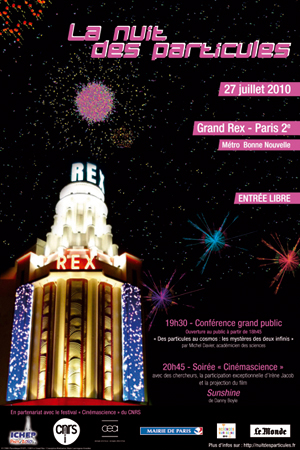PRESS INVITATION ICHEP 2010
 What are the latest results in the search for the Higgs boson? How are LHC experiments progressing? What are the first clues of the existence of dark matter? What is the latest on neutrinos?
What are the latest results in the search for the Higgs boson? How are LHC experiments progressing? What are the first clues of the existence of dark matter? What is the latest on neutrinos?
CNRS/IN2P3 (1) and CEA invite you to attend the press conference
LHC and high energy physics: latest results
On Monday 26 July 2010, at 1pm Paris time (CEST)
at the Palais des Congrès (Salle Maillot)
2 Place de la Porte Maillot - 75017 Paris, France
(Underground line 1 - Porte Maillot-Palais des Congrès, Regional railway line RER C Neuilly-Porte Maillot-Palais des Congrès)
From the LHC, through neutrinos to dark matter, the very latest results of high energy physics experiments will be unveiled at ICHEP 2010 (International Conference on High Energy Physics), which will bring together more than 1000 physicists from around the world from 22 to 28 July 2010 at the Palais des Congrès in Paris. ICHEP is the largest series of international conferences on particle physics in the world. It is the second time that this biennial event, inaugurated 60 years ago, is being held in Paris, the last occasion being in 1982. An unmissable meeting of minds in the field of high energy physics, ICHEP 2010 is organized by the French scientific community (CNRS/IN2P3 and CEA). The press conference will preview the latest results in particle physics, detail the key areas of progress in the field and outline the challenges and issues at stake.
With contributions from:
? Guy Wormser, CNRS Senior Researcher, Chairman of the local organization committee of the ICHEP conference and Director of the Laboratoire de l'Accélérateur Linéaire (LAL) in Orsay (Université Paris-Sud/CNRS-IN2P3). General introduction.
? Rolf Heuer, Director General of CERN(2). The latest results from pioneering particle physics experiments carried out on the LHC accelerator at CERN.
2010 is a turning point for high energy physics with the launch, last March, of the LHC (Large Hadron Collider) scientific program at CERN in Geneva. After smashing the energy record for the production of high energy collisions, the LHC has become the most powerful particle accelerator in the world. The first results of the program, in a still unexplored energy domain, will be disclosed at ICHEP 2010.
? Mel Shochet, Professor at the University of Chicago and Chairman of the High Energy Physics Advisory Panel (HEPAP) in the United States. The latest results from landmark particle physics experiments carried out on the Tevatron accelerator at Fermilab(3).
At the Tevatron in Chicago, United States, physicists have collected more data than ever before, opening the way to high-precision measurements that will allow the Standard Model, the current “theory” of particle physics, to be tested.
? Atsuto Suzuki, Director General of KEK(4) and Chairman of the International Committee for Future Accelerators (ICFA). Future accelerators and the main current developments in neutrino and astroparticle physics.
In astroparticle physics, recent studies carried out on the search for dark matter and on the oscillations of neutrinos have seen some very promising developments.
These leading scientists will then share their outlook for the future of high energy physics. The first progress reports on projects scheduled for the forthcoming decade will also be presented. This impressive agenda will make the ICHEP 2010 international conference a major scientific event at the very heart of current international scientific developments.
The press conference will be held in English and simultaneously translated into French. Access to the press conference in English will be possible via a telephone broadcast system. To obtain the number and access code, please contact Perrine Royole-Degieux at: royole@in2p3.fr
Since access to the Palais des Congrès is strictly controlled, please register for the press conference before 12am on 23 July 2010 by contacting Laetitia Louis, press officer, on +33 (0)1 44 96 51 37 or by email: laetitia.louis@cnrs-dir.fr
To find out more on ICHEP 2010: http://ichep2010.fr/
Source: CNRS/IN2P3 and CEA